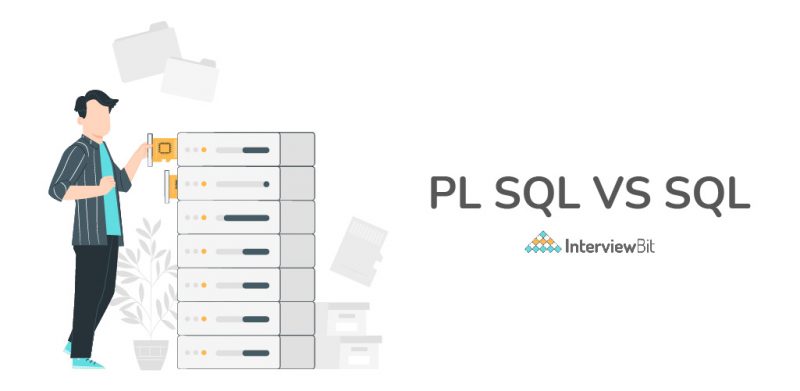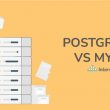- Introduction
- Difference Between SQL and PLSQL (Tabular)
- What is SQL?
- What is PL SQL?
- Key Differences
- Conclusion
- Frequently Asked Questions
- Q.1: Which is better: SQL or PL/SQL?
- Q.2: Why do we use PL/SQL instead of SQL?
- Q.3: Is Oracle SQL the same as PL/SQL?
- Q.4: Where is PL/SQL used?
- Q.5: Can we use PL/SQL in MySQL?
- Additional Resources
Introduction
Data is the most integral component for the functioning of any organization. With the increasing importance of data, the need to store such a vast chunk of data is necessary. This brings databases into the picture and when we talk about relational database languages, PL/SQL and SQL stand as one of the most popular. Although it might seem that PL/SQL and SQL are intertwined in many ways, there are actually several differences between the ways in which they operate. Unlike SQL which executes a single query at a time, PLSQL can execute a whole block of code at a time. PLSQL and SQL also differ in terms of their performance, error-handling capabilities, and database interaction. Be it an IT student or a database administrator, one must be acquainted with the differences between SQL and PL/SQL. So, let’s dive into knowing what these relational languages are and what are the differences between them.
Difference Between SQL and PLSQL (Tabular)

| SQL | PL/SQL |
| Essentially, SQL is a structured language used to query and manipulate data stored in databases. | It is a procedural language that is designed to implement SQL statements in a better way. |
| The query executes a single operation at a time. | Group of operations is performed in a single block. |
| SQL is declarative (program specifies what is to be done than how it is to be done). | PL/SQL is procedural (code that is written as a sequence of instructions). |
| SQL is used in relational databases to execute various queries like create table, delete table, insert into table, etc. | PL/SQL is used to write program blocks, procedures, functions, cursors, triggers, and packages. |
| SQL does not support data variables. | PL/SQL provides support for variable constraints and data types. |
| Control structures are not supported. | Control structures such as if-else, For loop, While loop are supported. |
| SQL is used to retrieve data from the database. We can modify data and table structure with SQL. | PL/SQL is used to create web applications and server pages. |
| It is possible to embed SQL in PLSQL syntax as PLSQL is an extension of SQL. | Embedding PL/SQL in SQL syntax is not possible. |
| SQL directly interacts with the database server. | PL/SQL does not directly interact with the database server. |
| Error handling feature is not present in SQL. | PL/SQL handles errors and exceptions effectively with the help of the inbuilt exception handlers. |
| Handling a large chunk of data can’t be effectively achieved by SQL. | PL/SQL handles a large chunk of data effectively with the help of procedures, functions and triggers. |
| When dealing with voluminous data, SQL offers a slower processing speed. | PL/SQL offers a high processing speed |
| Execution of statements in SQL does not result in reduced traffic as multiple statements cannot get executed at the same time. The queries are executed one at a time which increases the network traffic. | Execution of operation results in reduced network traffic as a block of statements is executed at once. |
| SQL is easy to use and understand. | Certain concepts of PL/SQL can be complex and prior knowledge might be necessary. |
| SQL does not support I/O operations. | PL/SQL supports I/O operations as it can accept inputs and then store and process it. |
| In SQL, we use both DML (Data Manipulation Language) and DDL (Data Definition Language) to write queries and commands. | The PL/SQL language, on the other hand, is composed of code blocks containing triggers, functions, variables, conditional statements (if..then..else), and control structures (for loops, whiles). |
| The SQL language allows for the execution of a single operation or query at a time. | PL/SQL, however, allows the execution of entire blocks or multiple operations at once. This reduces network traffic. |
What is SQL?
Structured Query Language (SQL) is a powerful, non-procedural, database language that is used to create, maintain and retrieve the relational database (a type of database that provides and stores data that are related to each other). Developed by IBM in the 1970s, it enables end-users to interact with several database management systems as per their availability.
SQL offers a larger degree of abstraction than procedural (code that is written as a sequence of instructions) languages and is quite user-friendly is very popular among programmers and is used by more than 50 percent of programmers. Some features of SQL are:
Confused about your next job?
- It is a Data Manipulation Language (DML) – It is used to modify data.
- It is Data Definition Language (DDL) – It contains instructions that will determine the data.
- It provides Client Service Execution and also
- helps in remote access to databases.
- It provides security and authentication features.
- It can be used to commit, roll back and save all
- our changes.
There are six types of commands in SQL. They are as follows:
- Data Manipulation Language (DML)
- Data Definition Language (DDL)
- Data Control Language (DCL)
- Transaction Control Language (TCL)
- Data Query Language (DQL)
Advantages of SQL
SQL has numerous advantages which makes it a highly popular and reliable language to use. Some of them are as follows:
- Coding skills are not needed – It is quite easy to manage the database without the need to write a large number of lines of code.
- High query processing speed – A huge chunk of data can be retrieved quickly and with high accuracy. Operations such as insertion, deletion, and manipulation of data also do not take much time.
- The standards are well defined – SQL has been accepted by ANSI and ISO/IEC as the standard language for a relational database. It also provides great documentation and a uniform platform worldwide to all its users. The community of SQL is so active that people and businesses get inclined toward technology.
- Portable – SQL can be used to program on PCs, servers, laptops, and some mobile phones independent of any platform.
- User-friendly – SQL is easy to learn and understand. It is a go-to relational language for beginners.
- Interactive Language – Easy to learn and understand, answers to complex queries can be received in seconds.
- Multiple data views – SQL can be used to make different views of the database structure. This means that it enables users to create virtual tables which also has rows and column – which in turn helps the users to analyze and slice the data in multiple ways to formulate different perspectives of the data.
Disadvantages of SQL
The disadvantages of SQL are given below:
- Complex interface – The interface offered by SQL is complex which sometimes makes it difficult for users to access.
- Partial Control – SQL programmers don’t have complete control over the database because of the hidden business rules.
- Operating Cost – The operating cost of some SQL versions is quite high which makes it difficult for some programmers to access it.
- Implementational Challenge – There are some databases available in markets that have SQL as a parent database. Hence, there is a vendor lock-in that needs to be addressed.
- Tables Dependency – When we create a view based on underlying tables of a database and change the structure of those tables. In such a case we will have to change the view as well. This makes the task more complex.
What is PL SQL?
PL/SQL is a procedural (code that is written as a sequence of instructions) language that enables programmers to combine the power of SQL with procedural statements. PL/SQL stands for Procedural Language extensions to SQL. In PL/SQL, all the statements are executed at once which consists of triggers, functions, procedures, etc, that enhance the functionality of an operation and decrease the traffic. Developed by Oracle Corporation in the 1990s, it was designed to build server pages and web applications and exhibits features such as abstraction and error handling.
The structure of a PL/SQL block consists of four parts: Declare, Begin, Exception and End. It is illustrated in the figure below.

Features of PL SQL
Some features of PL/SQL are:
- PL/SQL is tightly integrated with SQL. It possesses all capabilities of SQL.
- It helps in checking the error very precisely.
- There are a lot of different data types and data structures which are provided by PL/SQL.
- Structured programming is supported by the usage of functions and procedures. It has added support for OOPs (Object Oriented Programming)
- Development of Server Pages and Web Applications can also be achieved.
Advantages of PL SQL
There are numerous advantages of using PL/SQL. Some of them are mentioned below:
- Block Structures – Each PL/SQL block of code forms a unit of task and can be reused.
- Better performance – PL/SQL executes all statements in bulk rather than a single statement which increases the processing speed.
- Posses capabilities of procedural language – Conditional (if-else statements) and Iterative (loops such as for, while do-while) constructs are offered by PL/SQL.
- Supports error handling – Errors and exceptions are handled by PL/SQL with high accuracy.
Disadvantages of PL SQL
The disadvantages of PL/SQL are mentioned below:
- Limited I/O features – PL/SQL provides very limited support for I/O either to read/write files or to read from or write to a user interface.
- Complex syntax – Sometimes, PL/SQL is not very easy for programmers to follow due to its complex and inconsistent syntax.
- Proprietary to Oracle – It means that if one has to change the database vendors then the user would have to update all the existing Oracle PL/SQL code. It is a bit expensive.
- Not beginner-friendly – Certain concepts in PL/SQL can become difficult for beginners to understand
Key Differences
There are many differences between SQL and PL/SQL. SQL is a non-procedural language that executes a single query at a time whereas, PL/SQL is a procedural language and executes blocks of code at once which helps reduce traffic and increases processing speed. PL/SQL provides support features such as variables, conditional (if-else statements), and iterative (loops such as for, while) constructs. SQL does not provide support for these features. PL/SQL also offers error and exception-handling features that do not exist in SQL. PL/SQL is used to write a programming block that has procedures, functions, triggers, packages, and variables within its syntax. On the other hand, SQL queries and commands are written using DDL and DML.
Conclusion
The bottom line is that adding a new skill to your portfolio is always a wise decision, as it enhances both your potential and your earnings. PL/SQL is SQL combined with some added procedural features and it performs all the things that SQL performs but on large volumes of data using procedures, functions, control structures, cursors, and triggers. SQL tells us what data is needed but does not specify how it can be retrieved. This is where PL/SQL comes into the picture. The advent of PL/SQL has enabled us to deal with complex SQL problems with ease which earlier were a pain in the neck. In this era, data is the new oil and managing data has been of prime importance, unlike any other time. This makes the use of PL/SQL integral for the functioning of many organizations. Knowledge of SQL and PL/SQL can prove quite handy.
Frequently Asked Questions
Q.1: Which is better: SQL or PL/SQL?
Ans: PL/SQL is an extension of SQL and further includes many procedural features like function, data variables, exception handling, and triggers. Moreover, PL/SQL allows us to transfer an entire block of statements to the database at once whereas SQL executes a single query at a time. This reduces network traffic. Hence, PL/SQL is better than SQL.
Q.2: Why do we use PL/SQL instead of SQL?
Ans: PL/SQL allows us to transfer an entire block of statements to the database at once. This reduces traffic over the network and increases processing speed. This in turn increases the productivity of the programmers as they can create, transform and update data with high speed and accuracy. On the other hand, we can execute a single statement in SQL at a time.
Q.3: Is Oracle SQL the same as PL/SQL?
Ans: No, Oracle SQL is not the same as PL/SQL. Oracle SQL is Oracle’s version of the structured query language. On the other hand, PL/SQL is a Procedural Language developed by Oracle and is an extension of Oracle SQL having the functionalities of functions, control structures, and triggers.
Q.4: Where is PL/SQL used?
Ans: PL/SQL is mainly used to design web applications or create back-end logic for web pages. It is also used in integration with JAVA and PHP to create complex logic.
Q.5: Can we use PL/SQL in MySQL?
Ans: No, you cannot use PL/SQL in MySQL.







 Join WhatsApp Group
Join WhatsApp Group


